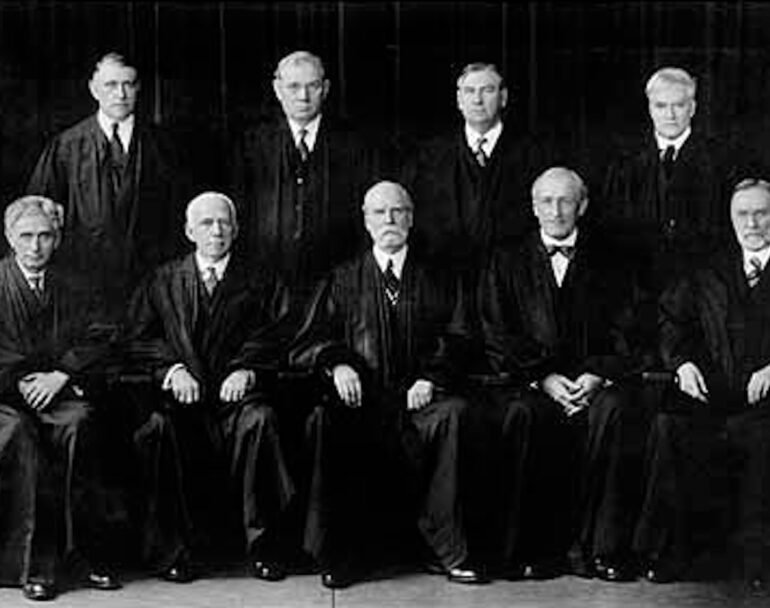
How the Supreme Court Rewrote the Constitution: 1937–1944
By Rob Natelson
Crisis and Depression
In October 1929, a financial bubble broke. As always happens when financial bubbles break, people lost a great deal and hardship ensued. But bubbles had been breaking for centuries. Wise people knew that in financial panics, most government intervention does more harm than good. They had learned that the best solution was for government to assist private charity in relieving the destitute, but otherwise allow the economy to reorganize and recover naturally.
However, most people aren’t wise. In times of hardship, they insist that government “do something.” Officeholders respond according to a classic political syllogism:
This is “something.”
Therefore, we must do this!
Unfortunately, “this” almost always exacerbates the damage or, at best, comes too late to be of much (or any) benefit.
There’s a common belief that President Herbert Hoover did relatively little to respond to the Depression but that President Franklin D. Roosevelt’s bold action largely cured it. This is untrue.
Hoover approved a steep tariff to protect American producers, and the Federal Reserve tightened credit. Hoover also approved massive federal spending. Conditions kept getting worse, and in 1932, Roosevelt defeated Hoover’s bid for reelection.
This wasn’t the first time federal politicians had responded to bubble-breakage with bubble-headed ideas. But before the 1930s, their limited constitutional powers curbed their ability to wreak havoc. Beginning in the 1930s, the Supreme Court allowed them to wreak havoc unimpeded.
The Supreme Court in 1934
In 1934, as now, the Supreme Court comprised nine justices. The chief justice was Charles Evans Hughes.
Hughes was one of America’s most respected statesmen. He had served as governor of New York, then as an associate justice on the Supreme Court. He resigned from the court to accept the Republican nomination for president in 1916, losing narrowly to Woodrow Wilson. He served as secretary of state in the Harding–Coolidge administration (1921–25) and then returned to the private practice of law. In 1930, Hoover sent him back to the court as chief justice.
Associate Justice Owen Roberts, another Republican Hoover appointee, was a fluctuating vote, somewhat like our present Chief Justice John Roberts. Overall, however, Owen Roberts moved left over time.
The other three Horsemen were James McReynolds, a Democrat and nasty anti-Semite who had been nominated by Wilson; Pierce Butler, a Democrat nominated by the Republican Harding; and Willis Van Devanter, a Republican nominated by Republican William Howard Taft.
In sum, the 1934 Supreme Court contained three conservative activists (McReynolds, Butler, and Van Devanter), two justices with mixed tendencies (Sutherland and Roberts), a moderate liberal (Hughes), and three staunch liberals (Stone, Brandeis, and Cardozo).
The Liberal/Progressive Philosophy
The liberals of the 1930s didn’t display the quasi-totalitarianism that mars the current “progressive” crowd. However, they did believe in a centralized “scientific” government by experts. That belief put them in tension with American constitutional principles of limited government and judicial neutrality.
In his majority opinion, Chief Justice Hughes used the occasion to outline liberal/progressive attitudes toward government and the Constitution. Here is an excerpt:
“There has been a growing appreciation of public needs and of the necessity of finding ground for a rational compromise between individual rights and public welfare. The … pressure of a constantly increasing density of population, the interrelation of the activities of our people and the complexity of our economic interests, have inevitably led to an increased use of the organization of society in order to protect the very bases of individual opportunity. Where, in earlier days, it was thought that only the concerns of individuals or of classes were involved and that those of the state itself were touched only remotely, it has later been found that the fundamental interests of the state are directly affected.
“If by the statement that what the Constitution meant at the time of its adoption it means to-day, it is intended to say that the great clauses of the Constitution must be confined to the interpretation which the framers, with the conditions and outlook of their time, would have placed upon them, the statement carries its own refutation. It was to guard against such a narrow conception that Chief Justice Marshall uttered the memorable warning: ‘We must never forget, that it is a Constitution we are expounding.’” What Hughes was saying was:
- Government must balance individual rights against the general welfare.
- Life is a lot more complicated and interrelated than formerly. Only the government can untangle this complexity.
- The Founders’ understanding doesn’t bind our interpretation of the Constitution. The claim that it does “carries its own refutation.”
- Traditional constitutional interpretations are “narrow.” (Progressives also called them “mechanical” and “formalistic.”)
- Chief Justice John Marshall’s views justify progressive reinterpretations.
Of course, all those ideas are subject to intelligent challenge.
One last point: Hughes badly misrepresented the views of Marshall. When Marshall wrote “We must never forget, that it is a Constitution we are expounding,” he wasn’t saying a judge should ignore the Constitution’s original meaning. He was explaining how to use a common rule of interpretation to find the Constitution’s original meaning.